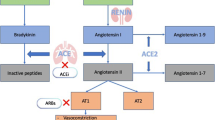Opinion statement
Angiotensin converting enzyme (ACE) inhibitors and angiotensin receptor blockers (ARBs) are antihypertensive agents that can be considered for migraine preventative therapy. Although the exact mechanisms by which ACE inhibitors and ARBs may work for migraine prophylaxis are unknown, there are several plausible hypotheses as to why modulating the activity of the renin angiotensin system could result in migraine prevention. Clinical trials of ACE inhibitors and ARBs provide evidence that they are effective and generally well tolerated when used for migraine prophylaxis. Based upon biologic plausibility, the quality of evidence for efficacy from clinical trials, and recommendations in published guidelines, we consider ACE inhibitors and ARBs as second- or third-line options for migraine prophylaxis.
Similar content being viewed by others
References and Recommended Reading
Papers of particular interest, published recently, have been highlighted as: • Of importance •• Of major importance
Lipton RB et al. Migraine prevalence, disease burden, and the need for preventive therapy. Neurology. 2007;68(5):343–9.
Munakata J et al. Economic burden of transformed migraine: results from the American migraine prevalence and prevention (AMPP) study. Headache. 2009;49(4):498–508.
Lipton RB, Silberstein SD. Episodic and chronic migraine headache: breaking down barriers to optimal treatment and prevention. Headache. 2015;55 Suppl 2:103–22. quiz 123–6.
Paterna S et al. Captopril versus placebo in the prevention of hemicrania without aura. A randomized double-blind study. Clin Ter. 1992;141(12):475–81.
Schrader H et al. Prophylactic treatment of migraine with angiotensin converting enzyme inhibitor (Lisinopril): randomised, placebo controlled, crossover study. BMJ. 2001;322(7277):19–22.
Sonbolestan SA et al. Efficacy of enalapril in migraine prophylaxis: a randomized, double-blind, placebo-controlled trial. Int J Prev Med. 2013;4(1):72–7. This is a recent randomized placebo-controlled trial of an ACE inhibitor for the preventative treatment of migraine.
Jackson JL et al. A comparative effectiveness meta-analysis of drugs for the prophylaxis of migraine headache. PLoS ONE. 2015;10(7):e0130733.
Shamliyan TA, Kane RL, and Taylor FR. In Migraine in adults: preventive pharmacologic treatments 2013: Rockville (MD).
Silberstein SD et al. Evidence-based guideline update: pharmacologic treatment for episodic migraine prevention in adults: report of the quality standards subcommittee of the American academy of neurology and the American headache society. Neurology. 2012;78(17):1337–45. These are evidence-based guidelines on the preventative treatment of migraine from the American Academy of Neurology and the American Headache Society.
Pringsheim T et al. Canadian headache society guideline for migraine prophylaxis. Can J Neurol Sci. 2012;39(2 Suppl 2):S1–59. These are evidence-based guidelines on the preventative treatment of migraine from the Canadian Headache Society.
Tronvik E et al. Prophylactic treatment of migraine with an angiotensin II receptor blocker: a randomized controlled trial. JAMA. 2003;289(1):65–9.
Diener HC et al. Telmisartan in migraine prophylaxis: a randomized, placebo-controlled trial. Cephalalgia. 2009;29(9):921–7.
Stovner LJ et al. A comparative study of candesartan versus propranolol for migraine prophylaxis: a randomised, triple-blind, placebo-controlled, double cross-over study. Cephalalgia. 2013;34(7):523–32. This is a recent randomized controlled trial of an ARB for the preventative treatment of migraine.
Marques-Lopes J et al. Microinjection of angiotensin II in the caudal ventrolateral medulla induces hyperalgesia. Neuroscience. 2009;158(4):1301–10.
Onder G et al. Association between ACE inhibitors use and headache caused by nitrates among hypertensive patients: results from the Italian group of pharmacoepidemiology in the elderly (GIFA). Cephalalgia. 2003;23(9):901–6.
Reuter U et al. Nuclear factor-kappaB as a molecular target for migraine therapy. Ann Neurol. 2002;51(4):507–16.
Lorenzo O et al. Angiotensin III activates nuclear transcription factor-kappaB in cultured mesangial cells mainly via AT(2) receptors: studies with AT(1) receptor-knockout mice. J Am Soc Nephrol. 2002;13(5):1162–71.
Iwai M et al. Attenuation of focal brain ischemia by Telmisartan, an angiotensin II type 1 receptor blocker, in atherosclerotic apolipoprotein E-deficient mice. Hypertens Res. 2008;31(1):161–8.
Horasanli B et al. Angiotensin I-converting enzyme gene (I/D) polymorphism in patients with migraine. Headache. 2013;53(1):161–4.
Kowa H et al. Association of the insertion/deletion polymorphism of the angiotensin I-converting enzyme gene in patients of migraine with aura. Neurosci Lett. 2005;374(2):129–31.
Paterna S et al. Angiotensin-converting enzyme gene deletion polymorphism determines an increase in frequency of migraine attacks in patients suffering from migraine without aura. Eur Neurol. 2000;43(3):133–6.
Lewandowski J et al. The effect of enalapril and Telmisartan on clinical and biochemical indices of sympathetic activity in hypertensive patients. Clin Exp Hypertens. 2008;30(5):423–32.
Tronvik E et al. Involvement of the renin-angiotensin system in migraine. J Hypertens Suppl. 2006;24(1):S139–43. This is a narrative review on how the renin-angiotensin system can play a role in migraine pathophysiology.
Shamliyan TA et al. Preventive pharmacologic treatments for episodic migraine in adults. J Gen Intern Med. 2013;28(9):1225–37.
Gales BJ et al. Angiotensin-converting enzyme inhibitors and angiotensin receptor blockers for the prevention of migraines. Ann Pharmacother. 2010;44(2):360–6.
Author information
Authors and Affiliations
Corresponding author
Ethics declarations
Conflict of Interest
Rashmi B. Halker M.D., Amaal J. Starling M.D., and Bert B. Vargas declare that they have no conflict of interest.
Todd J. Schwedt has received personal fees from Supernus, Allergan, and Zogenix.
Human and Animal Rights and Informed Consent
This article does not contain any studies with human or animal subjects performed by any of the authors.
Additional information
This article is part of the Topical Collection on Headache
Rights and permissions
About this article
Cite this article
Halker, R.B., Starling, A.J., Vargas, B.B. et al. ACE and ARB Agents in the Prophylactic Therapy of Migraine—How Effective Are They?. Curr Treat Options Neurol 18, 15 (2016). https://doi.org/10.1007/s11940-016-0397-2
Published:
DOI: https://doi.org/10.1007/s11940-016-0397-2



